Darwen Corporation Tramways
History
Darwen Corporation became a tramway owner on the 1st January 1899 as a result of taking over the tracks of the Blackburn and Over Darwen Tramways Company within the municipal boundary, as well as a proportion of its rolling stock and assets. The B&ODT system, which was built to a gauge of 4ft 0ins, essentially consisted of a single main line, 4.93 miles in length, running southwards from St Peter Street in the centre of Blackburn, through Ewood to the municipal boundary, then onwards through Darwen to Whitehall.
Both corporations intended to construct and operate 4ft 0ins-gauge electric tramway systems, but in the meantime, needed to continue running steam services until such time as they were in a position to carry out the conversion of the ex-B&ODT line. Agreement was reached between Darwen and Blackburn Corporations, the latter having purchased the tracks in its area, along with the remainder of the tramway engines and trailers, to operate the whole line under a short-term lease arrangement. As far as is known, other than owning the steam depot and a proportion of the engines and trailers, Darwen Corporation did not play any role in the day-to-day operation of the services.
The steam line, which had been built on the single line and loop principle, was doubled by the addition of a second track, and the new overhead electric infrastructure was installed. This enabled a smooth transition to electric traction, the first electric service commencing on the 17th October 1900. Although electric services were always operated jointly by Darwen Corporation Tramways and Blackburn Corporation Tramways, the latter did not initially have enough tramcars, so was forced to continue using the steam trams and trailers for around two weeks; the last steam service is thought to have operated on the 27th November 1900. From the 1st December 1900 onwards, DCT cars ran through to St Peter St in Blackburn and BCT cars ran through to Whitehall.
The DCT's only other tramway route ran eastwards from Darwen Circus to Hoddlesden, rising 250 ft in just over a mile; this was opened on the 11th October 1901, taking the system to its final form and size of 4.36 miles.
Little is known of the financial affairs of the DCT, but seeing as they continually invested in new tramcars, particularly after the Great War, during which the system would have been run down, it seems likely that the system was profitable. As well as new tramcars, the corporation also undertook a rebuilding programme in the mid 1920s, and took the opportunity to purchase spares from Rawtenstall Corporation Tramways in the early 1930s, a system which ran to the same gauge, and which was closing down.
It is assumed that the DCT suffered from unregulated competition by private bus operators in the 1920s, and that its acquisition of powers to run its own buses, was at least in part a response to this. The DCT's first bus service ran on the 19th September 1926, with further vehicles following in 1927, 1928 and 1930. As well as new routes, the buses were also used to supplement tram services on the Hoddlesden route, the trams working the heavily loaded rush-hour services.
Although two new extremely modern streamlined tramcars were purchased in 1936, it was probably around this time that the corporation took the decision to abandon the steeply graded Hoddlesden route, an event that took place on the 14th October 1937. The track on the main line to Blackburn seems to have been allowed to deteriorate, a process that was greatly accelerated by the heavy loadings and reduced maintenance of the Second World War. The corporation no doubt had tramway abandonment on its mind when it ordered further buses in 1942, a decision purportedly hastened by a fatal accident involving a DCT tram at Kidder St in Blackburn the previous year. The war was, however, to give the trams a temporary reprieve, the new buses not being delivered until late 1946.
The last DCT tram service ran on the 5th October 1946, the section of the old B&ODT between Whitehall and the municipal boundary (just after Earcroft) closing that day. A tram service did, however, continue on the remainder of the old route — operated by the BCT — until the 2nd July 1949.
Uniforms
At the commencement of electric services in 1900, staff wore uniforms which were very similar, if not identical to those of their close neighbour, Blackburn (see link). Jackets were single-breasted with five buttons — almost certainly made of nickel, and bearing the full system title (see link) — breast pockets and stand-up collars; it is currently unclear if the latter initially carried insignia (surviving photographs are of insufficient quality), though they certainly did so by the mid-Edwardian era (see later). The caps were in a drooping-peak style and bore a large oval cap badge of uncertain pattern, possibly of embroidered cloth. Long, double-breasted greatcoats bearing five pairs buttons, and high fold-over collars, were also provided to tramcar crews, and it is possible, but by no means certain, that the greatcoats bore some kind of embroidered insignia.
By late 1903, the style of tramcar crew jackets had been subtly altered; although they were still single-breasted with stand-up collars, the two breast pockets were now closed with triangular flaps rather than the square flaps used hitherto. Whereas motormen's jackets bore two breast pockets, conductors' jackets also had two waist-level pockets (with square flaps). The bearer's right-hand jacket collar now bore a grade badge — either 'Driver' or 'Conductor' — mirroring the practice of nearby Burnley and Manchester Corporations, whilst the left-hand collar bore an employee number. The drooping-peak caps were also dispensed with, being superseded by peaked caps with tensioned crowns (tops), the previous oval cap badges giving way to a small badge of unknown pattern, though almost certainly incorporating a municipal device (see below for a likely candidate).
For a short time in the late-Edwardian era, the edges and the pocket flaps of conductors' jackets were piped.
From circa 1911, the position of the grade and municipal-device badges were swapped, the grade badge thereafter being worn on the cap and the municipal-device badge on the right-hand jacket collar. swapped places.
Late in the system's life, probably in the 1930s or 1940s, the jacket style was changed to a more modern single-breasted design with four buttons, two scalloped-flap breast pockets (with button closures), and lapels; the collar insignia remained unchanged.
Darwen Corporation probably employed inspectors from the inception of the Blackburn Corporation-operated steam services in 1899 (over the lines of the former Blackburn and Over Darwen Tramways Company), as financial records from 1899/1900 indicate that salaries were paid and uniforms purchased (my thanks to Phil Calvey for this information).
In the years leading up to the Great War, inspectors wore very similar uniforms to tramcar crews, but without breast pockets, and edged in piping. The caps were identical to those worn by the tramcar crews, but with a nickel script-lettering grade badge, 'Inspector'. It is likely that inspectors' uniforms were changed in later years, though all that can be stated currently is that they were issued with gabardine-like overcoats after the Second World War, and that the caps appear simply to have borne a small badge, probably featuring the Darwen municipal device.
It is highly likely that Darwen, in common with the majority of British tramway systems, employed female staff during the Great War to replace male staff lost to the armed services; however, photographs are yet come to light, so it is impossible to say what uniforms were worn. Female staff were also employed in the Second World War and for a time thereafter; once again, photographic evidence is extremely sparse, with just a single example indicating that conductresses wore trousers (or were at least allowed to wear trousers) and double-breasted topcoats with lapels and epaulettes.
Further reading
For a very brief history of Darwen's tramways, see: 'The Tramways of Accrington 1886-1932' By R W Rush; Light Railway Transport League (1961).
Images
Motormen and conductors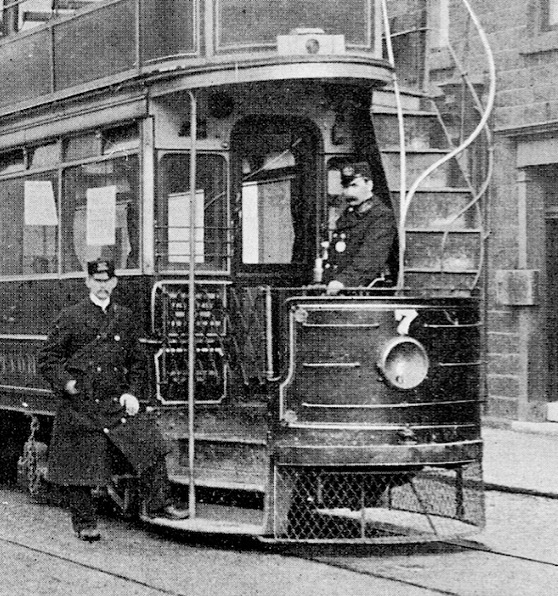
A rare early photograph of the crew of Darwen Corporation Tramways Tramcar No 7 — photo undated, but almost certainly taken in 1900 when electric services were introduced. Both men are wearing drooping-peak caps bearing what appears to be a large oval cap badge; unfortunately, an example has not survived, so details remain unknown. Photo courtesy of the Tramways and Light Railway Society.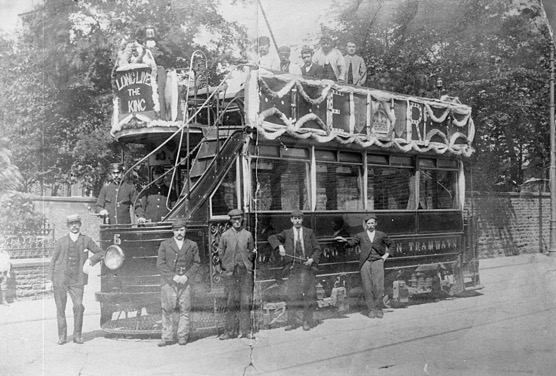
Tramcar No 5 decorated for the coronation of Edward VII in June 1902. The department's efforts were, however, in vain as the coronation was cancelled at short notice, finally taking place two months later in August. Photo courtesy of Phil Calvey.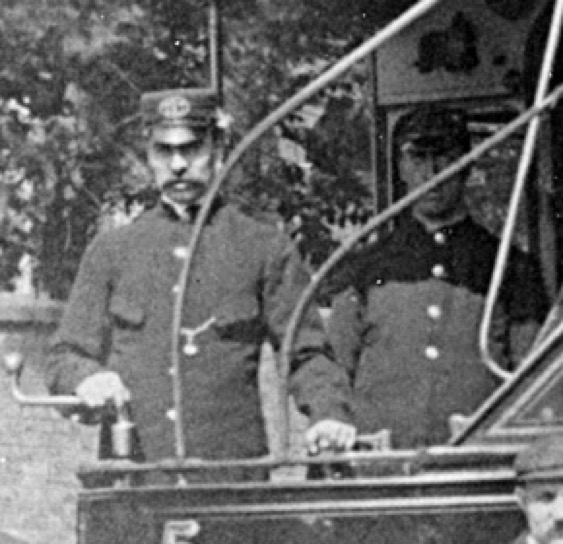
An enlargement of the above image showing the two uniformed tramway men. Both are wearing single-breasted tunics with stand-up collars, seemingly lacking collar insignia, along with drooping-peak caps bearing a large oval cap badge, possibly of embroidered cloth.
Darwen Corporation Tramways Milnes-built Tramcar No 1 outside the depot — photo undated, but almost certainly taken in the week preceding the 21st September 1903, when the play 'Circumstantial Evidence' opened; my thanks to Phil Calvey for this information. Whilst the tunics appear to be very similar to those seen in the earlier photos, the drooping-peak caps have been replaced by a more modern tensioned-crown style, and the large oval cap badge appears to have been dispensed with.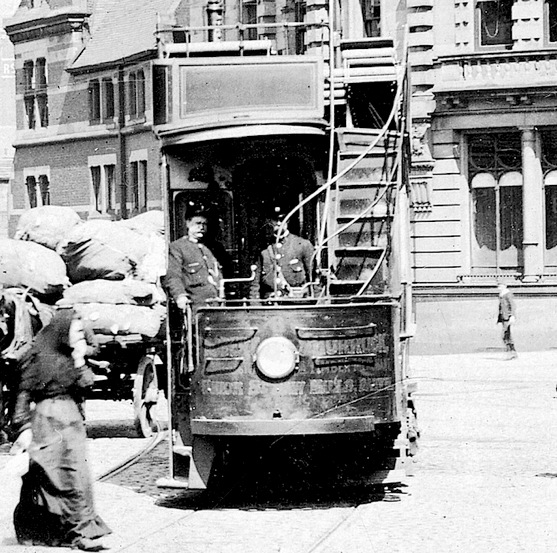
DCT No 6 and crew stand at The Circus in the centre of Darwen — photo undated, but probably taken in the mid-Edwardian era. The man on the left (the motorman) is wearing a grade badge on his right-hand jacket collar. Photo courtesy of Duncan Holden.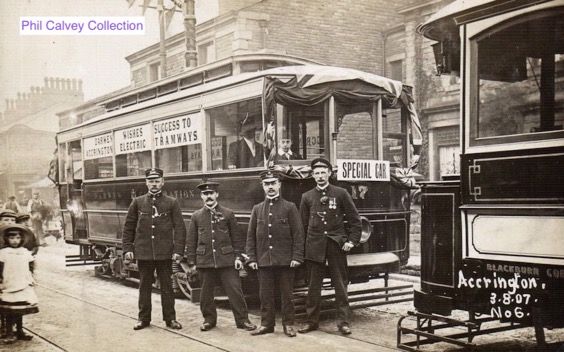
A photograph taken on the 3rd August 1907, the day Accrington Corporation Tramways' route to Oswaldtwistle was opened. The crews pictured are, however, not from Accrington, but from the neighbouring systems of Darwen and Blackburn, which sent trams to mark the occasion. Photo courtesy of Phil Calvey.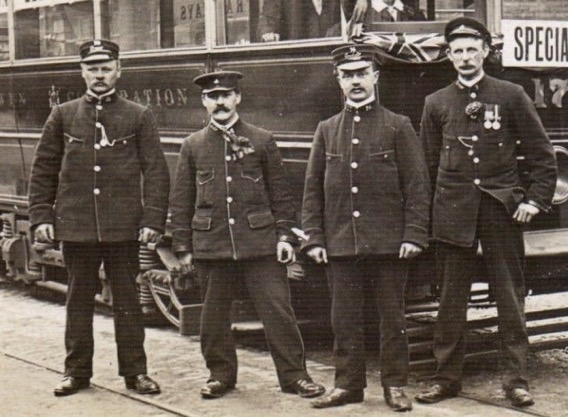
An enlargement of the above image showing the two crews, from left to right: a Blackburn motorman, a Darwen conductor, a Blackburn conductor, and a Darwen motorman. 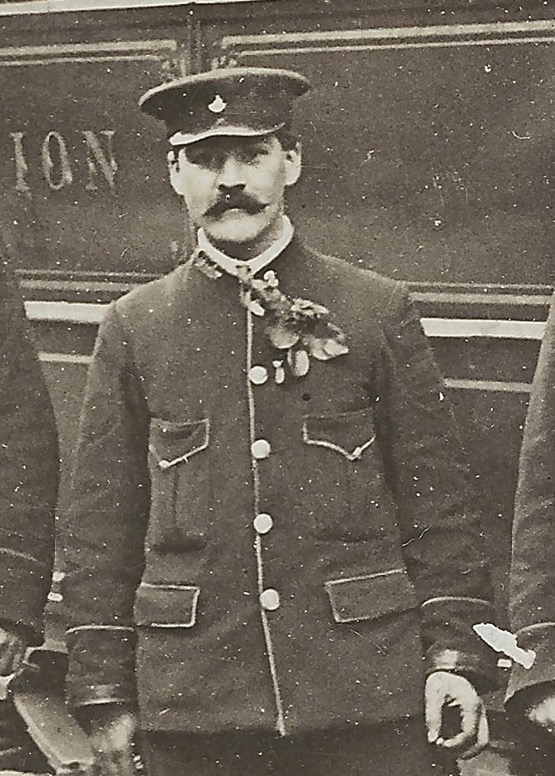
Another enlargement, this time showing the Darwen conductor, Employee No 2. He is wearing a small badge on his cap, presumably incorporating some kind of municipal device, along with a script-lettering grade badge — 'Conductor' — on his right-hand collar. The wearing of grade badges on jacket collars was highly unusual, but was most notably practiced by Manchester Corporation Tramways.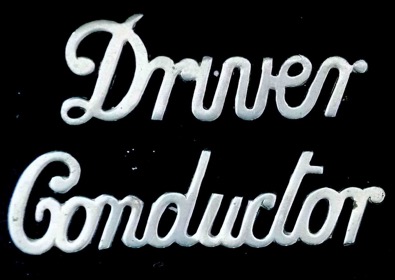
Script-lettering grade badges of the type worn by Darwen Corporation Tramways staff on their jacket collars between circa 1903 and circa 1911, and thereafter on their caps — nickel. Author's Collection.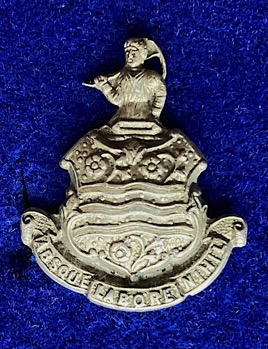
A Darwen municipal-device badge — nickel. This is almost certainly the pattern of badge worn on tramcar crew caps (from circa 1903 to circa 1911) and later on one uniform collar (from circa 1911 onwards). Author's Collection. 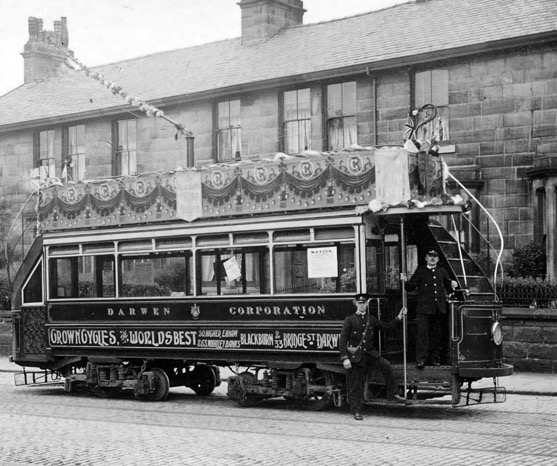
The crew of Darwen Corporation Tramways Tramcar No 10 pose for the cameraman in Bolton Road, Whitehall on the 22nd June 1911. Although difficult to make out, both men's caps bear small municipal-device badges, whilst their right-hand collars bear grade badges. Photo courtesy of Duncan Holden.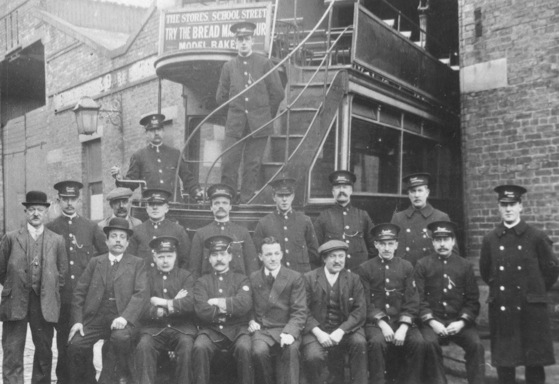
A number of staff assembled at the depot — photo undated, but very probably taken between 1912 and 1914. The man in the middle of the front row, who is wearing a lounge suit, is believed to be the manager, a Mr Hoskens, a position he took up in late 1912. Photo courtesy of Phil Calvey.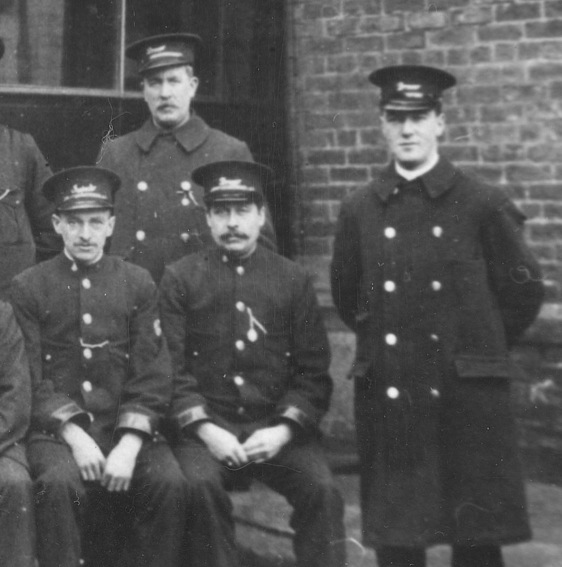
An enlargement of the above image showing three motormen and Inspector Orlando Haworth (left). Unlike the other two inspectors in the photograph, his uniform has pockets and is not piped, suggesting that he was recently promoted, and that his new uniform had yet to arrive. Photo courtesy of Phil Calvey.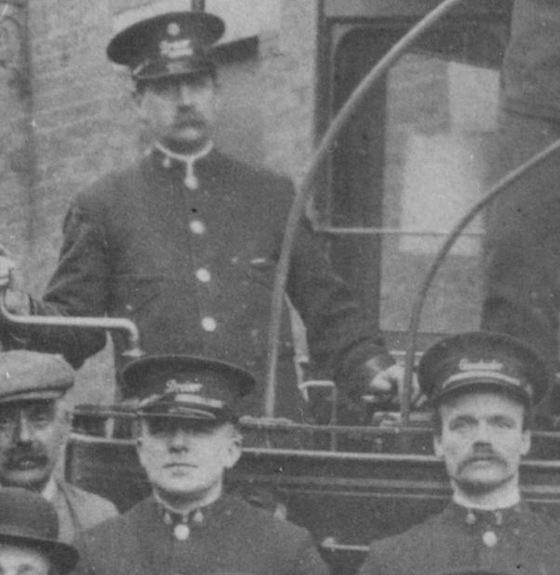
Another enlargement of the above photograph, this time showing two motormen and a conductor. The top-most motorman appears to be wearing a small circular badge above his script-lettering grade badge (on his cap), though he is the only one doing so of all the staff depicted. The right-hand jacket collars all carry a small badge, almost certainly bearing a municipal device, whilst the left-hand collars carry an employee number. Photo courtesy of Phil Calvey.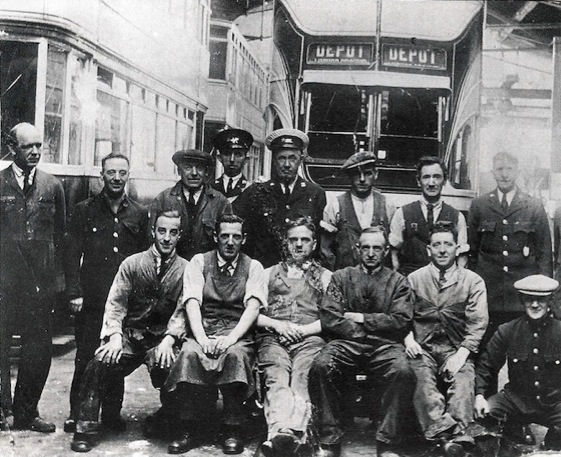
A depot photograph taken in 1936. Photo courtesy of Duncan Holden.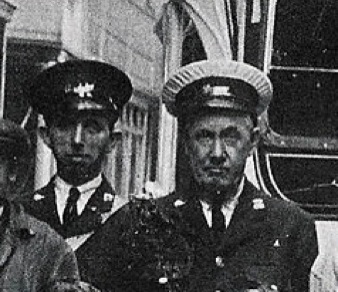
An enlargement of the above image, showing a conductor and motorman. With thanks to Duncan Holden.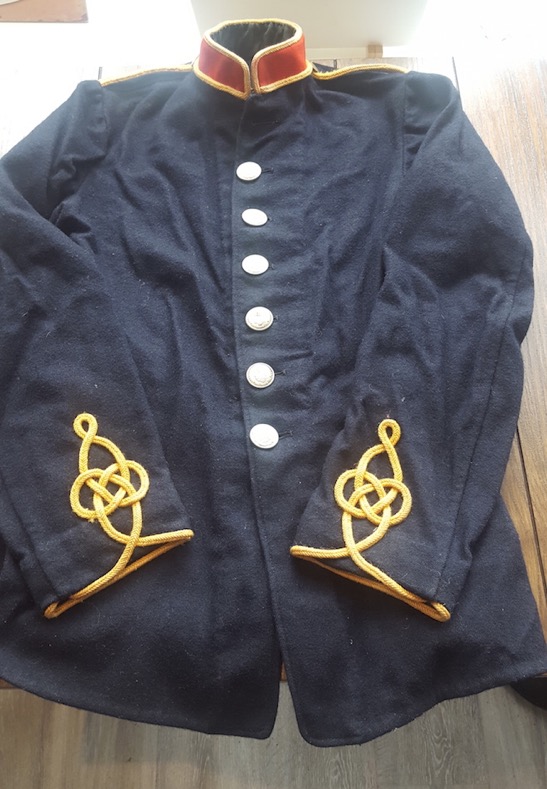
A Darwen Corporation Tramways tunic. Given the elaborate embellishments and the red collars, this is almost certainly a bandsman's jacket, presumably belonging to a member of Darwen Corporation Tramways Band (the buttons are standard DCT pattern — see link). Photo courtesy of Beckie Johnson.
Senior staff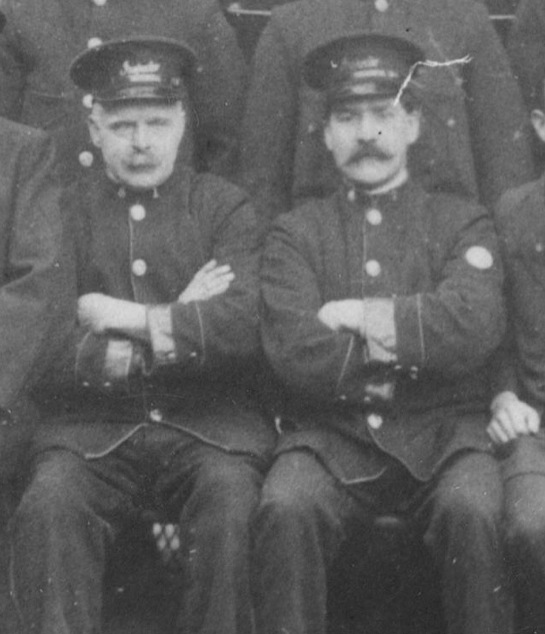
An enlargement of the c1911-1914 depot photograph above, showing two of the inspectors. In contrast to tramcar staff, their jackets are piped, and their caps carry script-lettering 'Inspector' grade badges. The meaning of the large circular badge on the right-hand arm of the right-most inspector is unclear. Photo courtesy of Phil Calvey.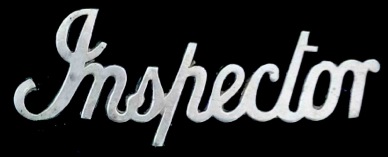
Script-lettering grade badge, of the type worn by Darwen Corporation Tramways inspectors on their caps — nickel. Author's Collection.
Female staff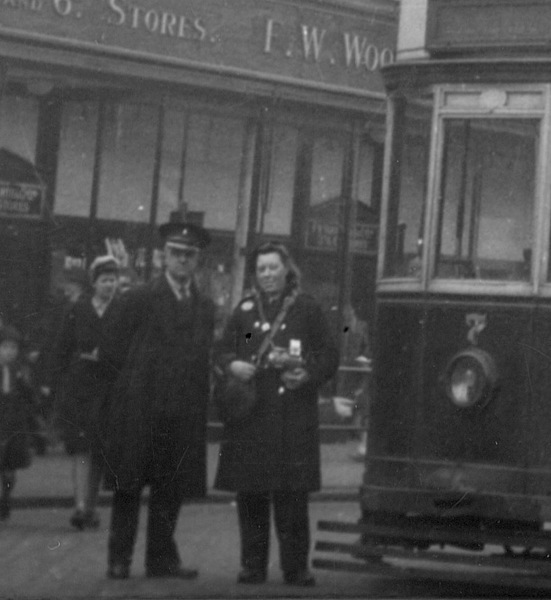
Conductress Lottie Clarke and an unidentified inspector pose with Tramcar No 7 at the Circus in Darwen — photo undated, but probably taken in 1945 or 1946. Photo courtesy of Phil Calvey.